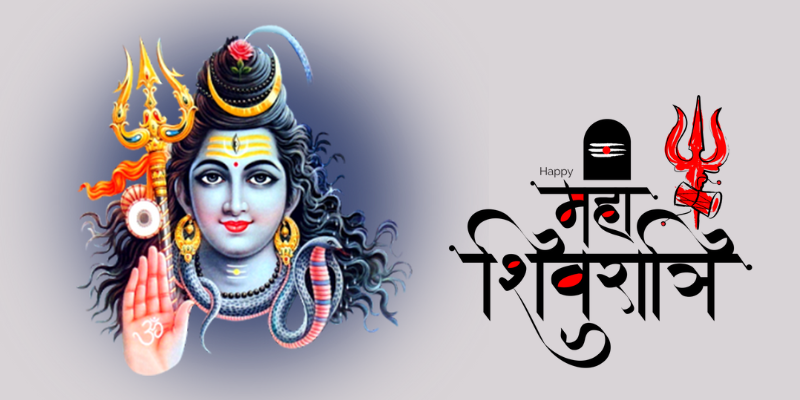
Mahashivratri, the great night of Lord Shiva, is one of the most important festivals in the Hindu calendar. It is celebrated annually in the month of Phalguna (February/March) on the fourteenth day of the dark fortnight (Krishna Paksha) of the Hindu lunar month.
The legend behind Mahashivratri dates back to ancient times when a hunter unknowingly entered a forest and ended up spending the night near a Shiva Linga (a phallic representation of Lord Shiva). The hunter unknowingly worshipped Lord Shiva by pouring water over the Shiva Linga, and as a result, Lord Shiva was pleased and blessed the hunter with his grace.
The day of Mahashivratri is considered auspicious for the worship of Lord Shiva. On this day, devotees visit Shiva temples, offer milk, flowers, fruits, and light incense sticks to seek the blessings of Lord Shiva. Devotees also observe fasts and stay awake all night, performing rituals and chanting the name of Lord Shiva.
 There are several legends associated with the origin of Mahashivratri. One of the most popular legends is that of the churning of the ocean (Samudra Manthan) by the Devas (gods) and Asuras (demons) to obtain the nectar of immortality. During the churning, a poison known as “halahala” emerged from the ocean, which had the power to destroy the world. Lord Shiva drank the poison to save the world, and his throat turned blue due to the poison. The incident is also known as “Neelkanth,” meaning the blue-throated one. The day Lord Shiva drank the poison is celebrated as Mahashivratri.
There are several legends associated with the origin of Mahashivratri. One of the most popular legends is that of the churning of the ocean (Samudra Manthan) by the Devas (gods) and Asuras (demons) to obtain the nectar of immortality. During the churning, a poison known as “halahala” emerged from the ocean, which had the power to destroy the world. Lord Shiva drank the poison to save the world, and his throat turned blue due to the poison. The incident is also known as “Neelkanth,” meaning the blue-throated one. The day Lord Shiva drank the poison is celebrated as Mahashivratri.
Another legend is that of the marriage of Lord Shiva and Goddess Parvati. It is believed that on the day of Mahashivratri, Lord Shiva and Goddess Parvati got married. Devotees celebrate the festival as a symbol of the divine union between Shiva and Parvati.
The significance of Mahashivratri lies in the belief that Lord Shiva, who is known as the destroyer of evil, blesses his devotees with peace, happiness, and prosperity. It is believed that by worshipping Lord Shiva on Mahashivratri, one can attain salvation and liberation from the cycle of birth and death.
Mahashivratri is not just a religious festival, but it is also a celebration of the divine power of Lord Shiva. It is a reminder that one should strive to attain the qualities of Lord Shiva, such as detachment, compassion, and self-realization.
 Mahashivratri is celebrated with great fervor and devotion across India and in various other countries where Hinduism is practiced. On this day, devotees offer prayers, perform rituals and observe fasts to seek the blessings of Lord Shiva. It is believed that fasting on Mahashivratri cleanses the body, mind, and soul and helps one attain salvation.
Mahashivratri is celebrated with great fervor and devotion across India and in various other countries where Hinduism is practiced. On this day, devotees offer prayers, perform rituals and observe fasts to seek the blessings of Lord Shiva. It is believed that fasting on Mahashivratri cleanses the body, mind, and soul and helps one attain salvation.
Special Fast Food for Mahashivratri:
While observing a fast on Mahashivratri, devotees abstain from consuming food that is considered to be ‘tamasic’ or ‘rajasic’ in nature. This includes non-vegetarian food, alcohol, tobacco, garlic, and onions. However, there are a variety of delicious and nutritious fast food items that one can enjoy on this auspicious day.
- Sabudana Khichdi: Sabudana khichdi is a popular dish that is made with soaked and drained sabudana (tapioca pearls), peanuts, potatoes, and spices. It is a light and easy-to-digest dish that is perfect for those observing a fast on Mahashivratri.
- Singhare ke atte ki puri: Singhare ke atte ki puri is a gluten-free and crispy flatbread that is made with water chestnut flour, mashed potatoes, and spices. It is a perfect accompaniment to sabudana khichdi or any other fasting dish.
- Fruit Salad: A bowl of fresh fruits like bananas, apples, grapes, and pomegranate is a healthy and refreshing option for those observing a fast on Mahashivratri. Fruits are rich in vitamins, minerals, and antioxidants that are essential for the body.
- Samak rice pulao: Samak rice or barnyard millet is a gluten-free and nutritious grain that is perfect for those observing a fast on Mahashivratri. Samak rice pulao is a flavorful dish that is made with samak rice, mixed vegetables, and spices.
- Makhana kheer: Makhana or foxnuts are a rich source of protein, fiber, and essential minerals. Makhana kheer is a delicious and creamy dessert that is made with milk, makhana, and sugar. It is a healthy and satisfying option for those with a sweet tooth.
In conclusion, Mahashivratri is a significant festival that is observed with great devotion and enthusiasm across India. While fasting on this auspicious day, one can indulge in a variety of delicious and nutritious fast food items that are not only satisfying but also beneficial for the body. So, celebrate Mahashivratri with your loved ones and enjoy these delectable fasting dishes.
